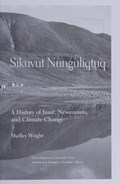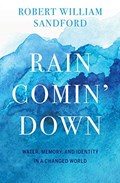Narrow Results By
Heart waters : sources of the Bow River
https://archives.whyte.org/en/permalink/catalogue25255
- Medium
- Library - Book (including soft-cover and pamphlets)
- Published Date
- 2015
- Author
- Van Tighem, Kevin
- Van Tighem, Brian
- Publisher
- [Victoria, British Columbia] : Rocky Mountain Books
- Edition
- First
- Call Number
- 03.5 V26h
1 website
- Responsibility
- Kevin Van Tighem (author)
- Brian Van Tighem (photographer)
- Edition
- First
- Publisher
- [Victoria, British Columbia] : Rocky Mountain Books
- Published Date
- 2015
- Physical Description
- 256 pages : colour illustrations, colour maps
- Abstract
- Water does not come from the river. It comes to the river. Heart Waters takes us to the sources of that water – and into the living beauty, human stories and future possibilities that also arise from the green uplands and valleys of Alberta’s Eastern Slopes, where the mighty Bow River is born. For more than a century the foothills and Front Range mountains of western Alberta have been recognized as being vital to the water supply for western Canada. Virtually all the water that sustains communities, ecosystems and the economy of prairie Canada comes from this narrow strip of land arrayed along the Continental Divide. For all its importance, however, water management decisions affecting this enormous region have ignored the significance of land health and focused almost exclusively on building dams. The result, as the author points out, is that the Bow River’s annual flows have decreased by more than a tenth, even as spring floods become more frequent and more destructive. The solutions to prairie Canada’s water challenges lie in healing the wounded landscapes of our headwaters. Heart Waters delves deeply into the history and ecology of a landscape whose critical value as a watershed is matched by its sheer beauty and diversity. A rich array of stunning images by Jasper-based photographer Brian Van Tighem complements the author’s well-researched explorations of the stories whispered by the living waters that drain from Banff National Park, Kananaskis Country and the famous ranchlands of the Bow River watershed. Kevin Van Tighem’s latest book is a deep exploration of place and an invitation to recognize that our water future depends upon knowing our headwaters better and caring for them more passionately — as our heart waters. (from publisher's website)
- Contents
- 1. Voices in the water -- 2. River origins: Bow River -- 3. A prodigal's return: Johnson Creek -- 4. Caterpillars and cutthroats: Quirk Creek -- 5. The past and future trout: Meadow Creek -- 6. Lake of the spirits: Cascade River and Ghost River -- 7. Dammed splendor: Kananaskis River -- 8. Buck-toothed volunteers: Bateman Creek -- 9. The under-river: Middle Bow River -- 10. Water and wildness: Sheep River -- 11. Cattle in the creek: Pekisko Creek -- 12. Mountains breathing: Highwood River -- 13. Healing the headwaters -- 14. Home and heart waters -- Index.
- Notes
- Shortlisted for the 2016 Banff Mountain Film and Book Festival award for Mountain & Wilderness Literature
- ISBN
- 9781771601399
- Accession Number
- P2020.07
- Call Number
- 03.5 V26h
- Collection
- Archives Library
- URL Notes
- Publisher's website
Websites
This material is presented as originally created; it may contain outdated cultural descriptions and
potentially offensive content.
Read more.
Legacy in ice : three generations of mountain photography in the Canadian West
https://archives.whyte.org/en/permalink/catalogue368
- Medium
- Library - Book (including soft-cover and pamphlets)
- Published Date
- 2014
- Author
- Vaux, Henry, Jr.
- Publisher
- Rocky Mountain Books
- Call Number
- 06.4 V46v
- Author
- Vaux, Henry, Jr.
- Responsibility
- Dr. Henry Vaux Jr.
- Publisher
- Rocky Mountain Books
- Published Date
- 2014
- Physical Description
- 125p : illl, ports
- Subjects
- Environment
- Glaciers
- Hydrology
- Notes
- Repeat photography comparing photographs taken by the Vaux family (George IX, William and Mary) in the late 19th and early 20th century to contemporary photographs by Henry Vaux Jr.
- ISBN
- 978-1-77160-060-6
- Accession Number
- P2015-01-20
- Call Number
- 06.4 V46v
- Collection
- Archives Library
This material is presented as originally created; it may contain outdated cultural descriptions and
potentially offensive content.
Read more.
Legacy in time : three generations of mountain photography in the Canadian West
https://archives.whyte.org/en/permalink/catalogue14441
- Medium
- Library - Book (including soft-cover and pamphlets)
- Published Date
- 2014
- Author
- Vaux, Henry
- Publisher
- Victoria, British Columbia : Rocky Mountain Books
- Call Number
- 06.4 V46l c.1
- 06 V46l c.2
- Author
- Vaux, Henry
- Responsibility
- Henry Vaux Jr.
- Publisher
- Victoria, British Columbia : Rocky Mountain Books
- Published Date
- 2014
- Physical Description
- 125 pages : illustrations, facsimiles, portraits, maps ; 23 cm
- Subjects
- Climatology
- Environment
- Glaciers
- Hydrology
- Photographers
- Photography
- Rocky Mountains, Canada
- Vaux family
- Notes
- Includes bibliography references
- Repeat photography of glacier formations in the mountains of Western Canada, comparing the photographs taken by Vaux family members in the late 19th and early 20th century with photographs taken by Henry Vaux Jr. of in the early 21st century
- ISBN
- 9781771600606
- Accession Number
- P2015-01-20
- tbd
- Call Number
- 06.4 V46l c.1
- 06 V46l c.2
- Collection
- Archives Library
This material is presented as originally created; it may contain outdated cultural descriptions and
potentially offensive content.
Read more.
MOUNTAINS TO METROPOLIS : the elbow river watershed
https://archives.whyte.org/en/permalink/catalogue25262
- Medium
- Library - Book (including soft-cover and pamphlets)
- Published Date
- 2015
- Author
- Coleman, Diane
- Publisher
- [Place of publication not identified], FRIESENPRESS
- Call Number
- 03.5 C67m
- 03.5 C67m reference copy
1 website
- Author
- Coleman, Diane
- Responsibility
- Diane Coleman
- Publisher
- [Place of publication not identified], FRIESENPRESS
- Published Date
- 2015
- Physical Description
- 261 pages
- Subjects
- Rivers
- Water
- Watersheds
- Hydrology
- Hydrology - Alberta
- Abstract
- Every watershed has a story: this is the Elbow’s. The Elbow River watershed is a small yet significant watershed extending from the Front Ranges of the Rocky Mountains to downtown Calgary. This geographical watershed is itself at a metaphorical watershed, due to increasing pressure for urban, industrial and recreational development which will alter the healthy functioning of its interdependent parts. Mountains to Metropolis combines the author’s own explorations in the watershed with comprehensive background information to place the reader in the watershed itself. Grizzly bears and mule deer, park wardens and cowboys, First Nations and first settlers, range cattle and coyotes, urbanites and beavers, city engineers and soldiers, Grey Nuns and missionaries – all are part of this watershed’s story. And each has shaped and been shaped by the physical and spiritual power of the river at the watershed’s core. While legislators, municipal managers, industry and residents all have a responsibility for making our watershed happy and healthy, in the end it comes down to the individual. The author lays out simple actions that we each can take in our daily lives. (from publisher's website)
- Contents
- Preface -- Acknowledgements -- Introductions -- Part 1. In the high mountains -- Part 2. The Foothills between -- Part 3. To plains and metropolis -- Part 4. Whither the Elbow -- Appendices: 1. Historical timeline: Elbow River watershed and region ; 2. Scientific names.
- ISBN
- 9781460271155
- Accession Number
- P2020.07
- 2024.26
- Call Number
- 03.5 C67m
- 03.5 C67m reference copy
- Collection
- Archives Library
- URL Notes
- Publisher's website
Websites
This material is presented as originally created; it may contain outdated cultural descriptions and
potentially offensive content.
Read more.
Our ice is vanishing = Sikuvut nunguliqtuq : a history of Inuit, newcomers, and climate change
https://archives.whyte.org/en/permalink/catalogue14385
- Medium
- Library - Book (including soft-cover and pamphlets)
- Published Date
- 2014
- Author
- Wright, Shelley
- Publisher
- Montreal : McGill-Queen's University Press
- Call Number
- 04 S5o
- Author
- Wright, Shelley
- Responsibility
- Shelley Wright
- Publisher
- Montreal : McGill-Queen's University Press
- Published Date
- 2014
- Physical Description
- xvi, 398 pages : illustrations, maps ; 25 cm
- Series
- McGill-Queen's native and northern series ; 75
- Notes
- Includes bibliographical references and index
- ISBN
- 9780773544628
- Accession Number
- P2015-01-20
- Call Number
- 04 S5o
- Collection
- Archives Library
This material is presented as originally created; it may contain outdated cultural descriptions and
potentially offensive content.
Read more.
Our vanishing glaciers : the snows of yesteryear and the future climate of the mountain West
https://archives.whyte.org/en/permalink/catalogue25256
- Medium
- Library - Book (including soft-cover and pamphlets)
- Published Date
- 2017
- Author
- Sandford, Robert W.
- Publisher
- [Victoria, British Columbia] : Rocky Mountain Books
- Edition
- First
- Call Number
- 03.4 Sa5o
1 website
- Author
- Sandford, Robert W.
- Responsibility
- Robert W. Sandford
- Edition
- First
- Publisher
- [Victoria, British Columbia] : Rocky Mountain Books
- Published Date
- 2017
- Physical Description
- 223 pages : illustrations (chiefly color), maps (chiefly color)
- Subjects
- Water
- Watersheds
- Rivers
- Glaciers
- Hydrology
- Hydrology - Alberta
- Rocky Mountains
- Climate change
- Abstract
- Written by one of the most respected experts in water and water-associated climate science and featuring stunning photography collected over the past four decades, Our Vanishing Glaciers explains and illustrates why water is such a unique substance and how it makes life on this planet possible. Focusing on the Columbia Icefield, the largest and most accessible mass of ice straddling the Continental Divide in western North America, and featuring photographs, illustrations, aerial surveys and thermal imaging collected over more than 40 years of the author’s personal observations, the book reveals the stunning magnitude of glacial ice in western Canada. Citing evidence to suggest that in the Canadian Rocky Mountain national parks alone, as many as 300 glaciers may have disappeared since 1920, this large-format, fully illustrated coffee table book graphically illustrates the projected rate of glacier recession in the mountain West over the rest of this century and serves as a profound testament to the beauty and importance of western Canada’s water, ice and snow. (from publisher's website)
- Contents
- 1. The wonder of water -- 2. What winter does to water -- 3. Ecology as defined by winter water -- 4. How ice fields and glaciers form -- 5. Canada's most accessible glaciers -- 6. The death of Peyto glacier : A case for more comprehensive -- 7. The Columbia ice field today -- 8. Glaciers in a changing climate -- 9. What we stand to lose -- 10. Water, climate and the National Parks ideal.
- Notes
- Winner, 2017 Lane Anderson Award for Best Canadian Science Writing
- ISBN
- 9781771602020
- Accession Number
- P2020.07
- Call Number
- 03.4 Sa5o
- Location
- Reading Room
- Collection
- Archives Library
- URL Notes
- Publisher's website
Websites
This material is presented as originally created; it may contain outdated cultural descriptions and
potentially offensive content.
Read more.
Prepare now for the next flood
https://archives.whyte.org/en/permalink/catalogue25113
- Medium
- Library - Periodical
- Published Date
- 2014
- Author
- Sandford, Robert
- Call Number
- P
1 website
- Author
- Sandford, Robert
- Published Date
- 2014
- Medium
- Library - Periodical
- Abstract
- The following is a condensed version of a recent presentation by Robert Sandford, EPCOR Chair of the Canadian Partnership Initiative in support of United Nations Water for Life Decade (from article) - pertains to the flood of the Bow River in 2013 and predicts more flooding
- Notes
- In Green Notes : CPAWS Calgary-Banff Chapter Newsletter, summer 2014, page 10-11
- Call Number
- P
- Collection
- Archives Library
- URL Notes
- CPAWS publications website
Websites
This material is presented as originally created; it may contain outdated cultural descriptions and
potentially offensive content.
Read more.
Rain comin' down : water, memory and identity in a changed world
https://archives.whyte.org/en/permalink/catalogue25257
- Medium
- Library - Book (including soft-cover and pamphlets)
- Published Date
- 2019
- Author
- Sandford, Robert W.
- Publisher
- [Victoria, British Columbia] : Rocky Mountain Books
- Edition
- First
- Call Number
- 03.5 Sa5r
1 website
- Author
- Sandford, Robert W.
- Responsibility
- Robert W. Sandford
- Edition
- First
- Publisher
- [Victoria, British Columbia] : Rocky Mountain Books
- Published Date
- 2019
- Physical Description
- 330 pages
- Subjects
- Water
- Watersheds
- Rivers
- Glaciers
- Hydrology
- Hydrology - Alberta
- Rocky Mountains
- Climate change
- Abstract
- Robert Sandford has spent a lot time watching and thinking about water. This was not because he was predisposed to do so, but because the importance of water gradually caught up with who he was and what he was doing with his life. As this self-reflective book demonstrates, when one takes up the serious study of water, one cannot but be surprised at how far that interest can take you: from the very origins of the cosmos right down to the unique structure and remarkable qualities of water as a molecule. It takes you to the depths of the oceans, to the upper reaches of the Earth’s atmosphere, and into the centres of storms. You fall to Earth with raindrops, travel tiny streams and great rivers, go round and round in lakes and ponds. Your study takes you down to the very roots of trees, into the soil, along the dark, dank banks of underground rivers. It takes you from one person’s thirst to the thirst of nations; from the demographics of the past to how those may drastically change in the absence of water in decades to come. Following water takes one back and forth in time, linking us to what the Earth was like in the past; what it is now; and how water will shape what it will be in the future. (from publisher's website)
- Contents
- Invocation - Rain comin' down
- Celestial rivers
- Rivers of cold
- Rivers of heat
- Rivers of words
- The heart of dryness
- Irrigating Eden
- Rivers of memory
- Rivers of ice
- As the world burns
- Learning from the burning: The summer of 2018
- Afterword - Rivers of hope
- Appendix - a Canadian National Glacier Act
- Bookshelf
- ISBN
- 9781771603171
- Accession Number
- P2020.07
- Call Number
- 03.5 Sa5r
- Collection
- Archives Library
- URL Notes
- Publisher's website
Websites
This material is presented as originally created; it may contain outdated cultural descriptions and
potentially offensive content.
Read more.
Understanding the Banff Hot Springs: through Karst hydrogeology
https://archives.whyte.org/en/permalink/catalogue25279
- Medium
- Library - Book (including soft-cover and pamphlets)
- Published Date
- 2019
- Author
- Yonge, Chas
- Publisher
- Altona, Manitoba : Friesens Corporation
- Edition
- First
- Call Number
- 03.5 Y7u
1 website
- Author
- Yonge, Chas
- Responsibility
- Chas Yonge
- Edition
- First
- Publisher
- Altona, Manitoba : Friesens Corporation
- Published Date
- 2019
- Physical Description
- 104 pages
- Subjects
- Hydrology
- Hydrology - Alberta
- Geography
- Geology - Alberta - Mountain Park
- Hot springs
- Banff
- Banff National Park
- Abstract
- The Banff Hot Springs is an iconic location with a long and storied history, having been first found and used by indigenous peoples. In 1883, Canadian Pacific Railway workers found the springs, which led to the development of Banff National Park and tourism in the Canadian Rockies. But the geologic history encompassed in the rocks of the Banff area extends back more than a billion years. In Understanding the Banff Hot Springs through Karst Hydrogeology, Chas Yonge looks at the Banff Hot Spring system from a new perspective: that of karst. Karst landforms are created by dissolution of rock, which leads to some of the most beautiful landscapes on the planet. This karst perspective leads to some very different conclusions regarding the nature of the hot springs. For example: How old is the thermal water? How far has it travlled underground? And how extensive are its pathways? Anyone with an interest in the science behind the Banff Hot Springs and exploring the local geology and landscape of the Canadian Rockies will find this book the perfect answer to their curiousity. Featuring a foreword by Arthur N. Palmer, Professor of Hydrogeology, Emeritus, at State University of New York. As of a few years ago, Chas Yonge was the former owner and operator of Canmore Cave Tours, offering interpretive tours underground. He has been an enthusiastic caver for almost 50 years, taking him all over the world. Since earning a PhD in karst paleoclimatology, he has applied isotope studies to karst, culminating in a number of publications. He has been an adjunct professor at the University of Calgary and is currently a fellow of the Royal Canadian Geographic Society. (From Amazon website)
- Contents
- Acknowledgements
- Foreward
- Hot springs in Canada where do you find them?
- Rocky Mountain geology around Banff
- Geological setting of the Banff Springs Hotel
- Sources and depth of the Banff thermal spring water
- Carbonate hot springs viewed as hypogene karst
- Hydrogeology of the the Rockies and Banff Hot Springs
- Flow nets developed along thurst faults
- Conduits developed along a thurst fault, nearby examples in Rats Nest Cave
- Hypogene recharge at the Banff Hot Springs: mechanisms and chemistry
- Epigene recharge; the invasion of cold, shallow groundwater at Banff
- Age of the groundwater
- Spring elevation: relevance to the Late Wisconsin Glaciation
- Tufa deposits and tufa caves
- Cave formation by microbes: tufa speleogenesis
- The cave deposits (speleothems)
- Banff Hot Springs Summary
- Appendices
- Glossary
- References and further reading
- Index
- About the author
- About the designer
- ISBN
- 9780987936936
- Accession Number
- P2020.07
- Call Number
- 03.5 Y7u
- Collection
- Archives Library
- URL Notes
- Further research via Research Gate
Websites
This material is presented as originally created; it may contain outdated cultural descriptions and
potentially offensive content.
Read more.
Where rivers meet : photographs and stories from the Bow Valley and the Kananaskis
https://archives.whyte.org/en/permalink/catalogue25282
- Medium
- Library - Book (including soft-cover and pamphlets)
- Published Date
- 2018
- Author
- Legault, Stephen
- Publisher
- [Victoria, British Columbia] : RMB
- Call Number
- 03.5 L46w
1 website
- Author
- Legault, Stephen
- Responsibility
- Stephen Legault
- Publisher
- [Victoria, British Columbia] : RMB
- Published Date
- 2018
- Physical Description
- 208 pages : illustrations (some colour), colour maps
- Subjects
- Hydrology
- Hydrology - Alberta
- Rivers
- Water
- Watersheds
- Bow River Basin
- Spray River
- Highwood Pass
- Maps
- Photography
- Abstract
- Until the 1980s, Kananaskis Country, the Bow Valley and Canmore were places most people drove past on their way to Ban National Park, Lake Louise, Jasper and points beyond. Today, Kananaskis Country gets more than three million visitors a year, and Canmore is a town twice the size of Banff. Encompassing a dizzying array of natural environments, from grasslands and foothills to deep mountain valleys and sweeping alpine vistas, Kananaskis Country and the Bow Valley attract visitors from around the world each year to this mountain paradise. Calgarians consider this landscape to be their backyard and they turn to it for recreation, solace and wilderness adventure. Where Rivers Meet will bring the beauty and wonder of this profound landscape and its wild creatures to visitors from around the world and local residents alike. This artistically designed coffee table book features over 200 black and white and colour images together with short essays and personal reflections on natural history, geology, the cultural background and the region’s communities, as well as the threats and solutions to development and social challenges found throughout Kananaskis Country and the Bow Valley. (From publisher's website)
- Contents
- Introduction
- The Bow Valley
- The Spray Valley
- The Kananaskis Valley
- The Highwood/Cataract
- The Elbow and Sheep Rivers
- Oz-ada Imne
- Epilogue: A love song
- Gratitude
- About the author
- Maps
- ISBN
- 9781771602396
- Accession Number
- P2020.07
- Call Number
- 03.5 L46w
- Location
- Reading Room
- Collection
- Archives Library
- URL Notes
- Publisher's website
Websites
This material is presented as originally created; it may contain outdated cultural descriptions and
potentially offensive content.
Read more.








